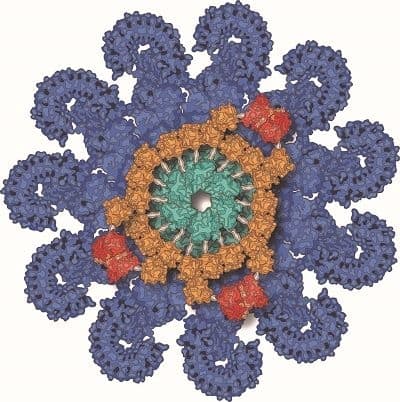Circumventing the activation of an immune system complex that drives inflammation, which is known as the NLRP3 inflammasome, could prevent the collection of abnormal tangles of the protein tau in the brain, according to a new study in mice. The findings, published in Nature, also showed that this inflammasome is a key step in the pathway between abnormal amyloid-beta plaques in the brain and tau tangles. Both plaques and tangles are hallmarks of Alzheimer’s disease.
An inflammasome is a complex of proteins within a cell that can activate inflammatory molecules, like caspase-1, and induce inflammation. When the inflammasome goes rogue, inflammatory disorders can result, and they’ve been implicated in neurodegenerative diseases like Alzheimer’s. Previous studies in mice have shown that beta-amyloid plaques in the brain can activate the NLRP3 (NOD-like receptor 3) inflammasome. After caspase-1 is activated, interleukins (ILs) like IL-1 beta are activated, too.
Because excessive inflammation can lead to disease, a research team — led by investigators at the University Hospital of Bonn in Germany with collaborators at the University of Texas Medical Branch in Galveston and the University of Massachusetts in Worcester — set out to remove or block the inflammasome to determine its effect on signs of neurodegenerative diseases such as Alzheimer’s disease and frontotemporal dementia (FTD). By examining brain samples from people who had FTD, the researchers discovered increased levels of caspase-1 and IL-1 beta, as well as other signs that the NLRP3 inflammasome was activated. This finding provided some evidence that the NLRP3 inflammasome may be involved in the early stage of FTD and other tau-related neurodegenerative disorders.
Next, the researchers looked for signs of activation of the NLRP3 inflammasome in genetically engineered lab mice, known as Tau22 mice, which develop tau tangles in the brain as they grow older. By comparing 11-month-old (middle-aged) Tau22 mice to normal mice and to 3-month-old (young) Tau22 mice, the researchers found that signs of activation were higher in 11-month-old Tau22 mice. Analysis of gene expression provided additional evidence of activated caspase-1 and IL-1 beta in Tau22 mice.
The researchers then studied Tau22 mice that did not have the NLRP3 inflammasome. These mice had lower levels of activated caspase-1 and IL-1 beta, lacked tau tangles and performed better on memory tests than the Tau22 mice with the NLRP3 inflammasome.
When the researchers injected various forms of tau protein — individual strands of tau, bound strands known as oligomers, and tau tangles — into the brains of the Tau22 mice, only individual tau and oligomeric tau proteins, and not tau tangles, significantly activated IL-1 beta. The investigators then successfully used an NLRP3-blocking drug to prevent IL-1 beta activation in the mice receiving individual tau proteins. These findings suggest that individual tau and oligomeric tau proteins, but not tau tangles, activate the NLRP3 inflammasome.
In further tests, the research team showed that beta-amyloid plaques can also activate the NLRP3 inflammasome, which affected tau. This suggests that NLRP3 activity might be a key step in the pathway from beta-amyloid plaques to tau tangles forming in the brain. For mice that have tau pathology, NLRP3 inflammasome seems to be essential for the tau aggregation, the authors suggested.
Although this was a study with mice rather than people, these findings provide evidence that preventing the activity of the NLRP3 inflammasome interferes with the pathway that leads to tau tangles. Because this inflammasome also seems to play a role in the pathway from beta-amyloid plaques to tau tangles, the authors conclude that blocking it may be of benefit to people with Alzheimer’s disease.
This research was funded in part by NIA grants R01AG054025 and R01AG059752.
It relates to NIA’s AD+ADRD Research Implementation Milestones Milestones 2.N “Research on Disease Mechanisms.”
Reference: Ising C, et al. NLRP3 inflammasome activation drives tau pathology. Nature. 2019;575(7784):669-673. doi: 10.1038/s41586-019-1769-z.

